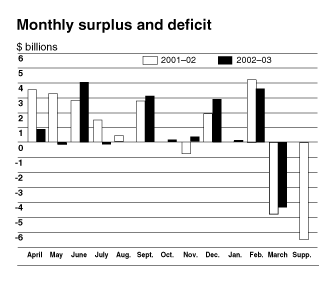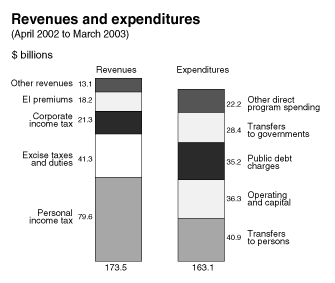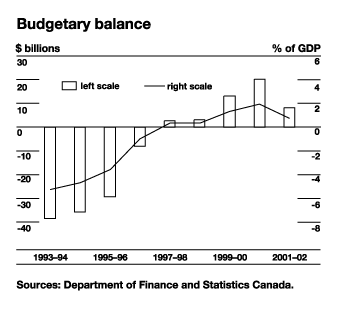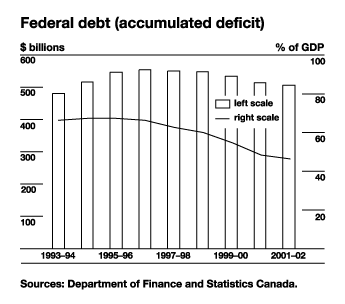|
|
The Fiscal Monitor
Highlights of financial results for March 2003
- Adobe Acrobat Version (63.41 Kb).
HighlightsMarch 2003: budgetary deficit of $4.4 billion There was a budgetary deficit of $4.4 billion in March 2003, down $0.4 billion from the deficit of $4.8 billion in March 2002. A large deficit was expected in March, as these results are affected by the inclusion of personal income tax refunds relating to the previous taxation year. On a year-over-year basis, budgetary revenues increased by $0.6 billion, or 4.9 per cent, program spending declined by $0.1 billion, or 0.8 per cent, while public debt charges increased by $0.2 billion, or 8.2 per cent. April 2002 to March 2003: budgetary surplus of $10.4 billion The budgetary surplus was estimated at $10.4 billion for the April 2002 to March 2003 period, down $4.3 billion from the surplus of $14.7 billion reported in the same period of 2001-02. The decline in the year-over-year surplus is largely attributable to developments affecting personal and corporate income tax revenues with respect to the 2001 tax year. This deterioration reflects the decline in the stock market in 2001, which resulted in higher refunds and lower settlement payments in April and May 2002, and higher corporate income tax refunds and lower final settlement payments, as corporations are applying losses experienced in 2001 to taxes paid in previous years or owing in 2002. These are not the final results for the 2002-03 fiscal year. Still to come are the regular end-of-year adjustments, which incorporate the costs of liabilities incurred during the fiscal year for which no payments were made in 2002-03. This year these will include initiatives proposed in the February 2003 budget, including the $2.5-billion Canada Health and Social Transfer (CHST) supplement, the $1.5-billion Diagnostic/Medical Equipment Fund, $0.6 billion for health information technology and $0.5 billion to the Canada Foundation for Innovation, which will be charged to the 2002-03 fiscal year, pending passage of the budget legislation currently before Parliament. In addition, the monthly financial results to date for both 2001-02 and 2002-03 have been presented on a modified accrual basis of accounting. The 2003 budget estimates for these years as a whole were presented on a full accrual basis of accounting, and the final fiscal results for 2002-03 will be presented on a full accrual basis. In 2001-02 end-of-year adjustments and the impact of moving to full accrual accounting reduced the budgetary surplus for the April 2001 to March 2002 period from $14.7 billion to $8.2 billion at fiscal year end. Taking these factors into consideration, the results to date are consistent with the expected outcome for 2002-03, as set out in the 2003 budget. Final results for 2002-03 will be released in the fall of 2003. |


Table 1
Summary statement of transactions
|
|
||||
|
March |
April to March | |||
|---|---|---|---|---|
|
2002 |
2003 |
2001-02 |
2002-03 |
|
|
|
||||
|
($ millions) |
||||
|
Revenues |
11,624 |
12,189 |
174,129 |
173,490 |
|
Program spending |
-13,669 |
-13,558 |
-121,369 |
-127,862 |
|
|
|
|||
|
Operating surplus |
-2,045 |
-1,369 |
52,760 |
45,628 |
|
Public debt charges |
-2,757 |
-2,982 |
-38,059 |
-35,213 |
|
|
|
|||
|
Budgetary balance (deficit/surplus) |
-4,802 |
-4,351 |
14,701 |
10,415 |
|
7,244 |
6,970 |
-8,894 |
-8,416 |
|
|
Financial requirements/source |
2,442 |
2,619 |
5,807 |
1,999 |
|
|
|
|||
|
Foreign exchange transactions |
-732 |
-421 |
-1,849 |
3,912 |
|
Net financial balance |
1,710 |
2,198 |
3,958 |
5,911 |
|
Net change in borrowings |
267 |
6,606 |
-5,189 |
-3,119 |
|
Net change in cash balances |
1,977 |
8,804 |
-1,231 |
2,792 |
|
Cash balance at end of period |
11,950 |
14,740 |
||
|
|
||||
|
Note: Positive numbers indicate a net source of funds. Negative numbers
indicate a net requirement for funds. |
||||
March 2003: budgetary results
The budgetary deficit was $4.4 billion in March 2003, an improvement of $0.4 billion from March 2002. This improvement is attributable to the timing of receipts between February and March and the inclusion in the March 2002 results of a number of policy initiatives announced in the December 2001 budget.
Budgetary revenues increased by $0.6 billion, or 4.9 per cent, primarily due to stronger advances in personal and corporate income tax revenues. Among the various revenue components:
- Personal income tax revenues were up $0.4 billion, or 9.0 per cent, due to higher deductions from employment income, reflecting the strong growth in employment, and a decline in refunds.
- Corporate income tax revenues were up $0.6 billion, or 50.3 per cent, reversing most of the year-over-year decline in the previous month. This reflects the timing of receipts.
- Employment insurance (EI) premium revenues were virtually unchanged, as the impact of the growth in the number of people employed and therefore paying premiums was offset by the decline in premium rates (the employee rate for 2003 is $2.10 per $100 of insurable earnings compared to $2.20 in 2002).
- Excise taxes and duties were down $0.4 billion, or 16.7 per cent, due to higher goods and services tax (GST) refunds. Net GST revenues were down $0.6 billion, or 36.3 per cent. In contrast, customs import duties and other excise taxes and duties were somewhat higher.
- Non-tax revenues were down slightly on a year-over-year basis.
On a year-over-year basis, program spending was down $0.1 billion, or 0.8 per cent. This decline is attributable to the impact of new policy initiatives announced in the December 2001 budget, which were included in the March 2002 results. In contrast, the new initiatives proposed in the February 2003 budget, totalling $5.2 billion, will be included as part of the end-of-year adjustments, pending passage of the budget legislation.
- Transfers to persons increased $0.2 billion, or 4.9 per cent, attributable to both higher EI and elderly benefits.
- Transfers to other levels of government were up $0.2 billion, or 12.3 per cent, reflecting higher entitlements under both the CHST and fiscal transfer programs. The increase in the CHST reflects the September 2000 agreement reached by first ministers to increase base funding from $17.3 billion in 2001-02 to $18.6 billion in 2002-03.
Table 2
Budgetary revenues
|
|
||||||
|---|---|---|---|---|---|---|
|
March |
April to March | |||||
|
2002 |
2003 |
Change |
2001-02 |
2002-03 |
Change |
|
|
|
||||||
|
($ millions) |
(%) |
($ millions) |
(%) | |||
|
Income taxes |
||||||
|
Personal income tax |
4,228 |
4,609 |
9.0 |
81,760 |
79,589 |
-2.7 |
|
Corporate income tax |
1,272 |
1,912 |
50.3 |
24,637 |
21,300 |
-13.5 |
|
Other income tax revenue |
655 |
634 |
-3.2 |
4,038 |
4,360 |
8.0 |
|
|
|
|||||
|
Total income tax |
6,155 |
7,155 |
16.2 |
110,435 |
105,249 |
-4.7 |
|
Employment insurance |
1,774 |
1,775 |
0.1 |
17,960 |
18,203 |
1.4 |
|
Excise taxes and duties |
||||||
|
Goods and services tax |
1,582 |
1,007 |
-36.3 |
25,275 |
28,307 |
12.0 |
|
Customs import duties |
220 |
272 |
23.6 |
2,979 |
3,203 |
7.5 |
|
Other excise taxes and duties |
700 |
763 |
9.0 |
8,641 |
9,398 |
8.8 |
|
Air Travellers Security Charge |
42 |
379 |
||||
|
|
|
|||||
|
Total excise taxes and duties |
2,502 |
2,084 |
-16.7 |
36,895 |
41,287 |
11.9 |
|
|
|
|||||
|
Total tax revenues |
10,431 |
11,014 |
5.6 |
165,290 |
164,739 |
-0.3 |
|
Non-tax revenues |
1,193 |
1,175 |
-1.5 |
8,839 |
8,751 |
-1.0 |
|
|
|
|||||
|
Total budgetary revenues |
11,624 |
12,189 |
4.9 |
174,129 |
173,490 |
-0.4 |
|
|
||||||
- Direct program spending, consisting of total program spending less transfers to persons and other levels of government, was down $0.5 billion, or 6.5 per cent. Subsidies and other transfers declined $0.3 billion, primarily due to the impact of the December 2001 budget initiatives on the March 2002 results. Defence spending was also lower due to incremental costs in March 2002 for security measures.
Public debt charges, on a year-over year basis, were up $0.2 billion, or 8.2 per cent, due to an increase in the stock of interest-bearing debt.
April 2002 to March 2003: budgetary results
Over the April 2002 to March 2003 period, the budgetary surplus was estimated at $10.4 billion, compared to a surplus of $14.7 billion reported in the same period of 2001-02. This decline reflects lower budgetary revenues, largely attributable to developments related to the 2001 tax year, and higher program spending. In contrast, public debt charges were lower.
Over the April 2002 to March 2003 period, budgetary revenues were down $0.6 billion, or 0.4 per cent, on a year-over-year basis. Among the major components:
- Personal income tax collections were down $2.2 billion, or 2.7 per cent. Virtually all of this decline is attributable to lower final tax payments and higher refunds with respect to the 2001 tax year, reflecting weakness in the stock market and the associated lower net capital gains realizations. Quarterly instalment payments were also lower, as these payments are now largely based on tax liabilities for 2001. However, it should be noted that the results for the same period in 2001 were affected by the extraordinary stock market gains in 2000, which resulted in record final tax settlement payments in April and May 2001. On a full accrual basis of accounting, these impacts will be recorded in the year in which the taxable activity took place. The results to date were also dampened by the impact of the tax reduction measures announced in the February 2000 budget and October 2000 Economic Statement and Budget Update. Partially offsetting these impacts were higher taxes associated with increases in employment income.
Table 3
Budgetary expenditures
|
|
||||||
|---|---|---|---|---|---|---|
|
March |
|
April to March | ||||
|
2002 |
2003 |
Change |
2001-02 |
2002-03 |
Change |
|
|
|
||||||
|
($ millions) |
(%) |
($ millions) |
(%) | |||
|
Persons |
||||||
|
Elderly benefits |
2,157 |
2,238 |
3.8 |
25,364 |
26,344 |
3.9 |
|
Employment insurance benefits |
1,479 |
1,576 |
6.6 |
13,852 |
14,594 |
5.4 |
|
|
|
|||||
|
Total |
3,636 |
3,814 |
4.9 |
39,216 |
40,938 |
4.4 |
|
Other levels of government |
||||||
|
Canada Health and Social Transfer |
1,442 |
1,550 |
7.5 |
17,300 |
18,600 |
7.5 |
|
Fiscal transfers |
713 |
820 |
15.0 |
12,146 |
12,304 |
1.3 |
|
Alternative Payments for |
-232 |
-210 |
-9.5 |
-2,563 |
-2,522 |
-1 |
|
|
|
|||||
|
Total |
1,923 |
2,160 |
12.3 |
26,883 |
28,382 |
5.6 |
|
Direct program spending |
||||||
|
Subsidies and other transfers |
||||||
|
Agriculture |
84 |
193 |
129.8 |
798 |
1,393 |
74.6 |
|
Foreign Affairs |
566 |
742 |
31.1 |
2,131 |
2,256 |
5.9 |
|
Health |
317 |
163 |
-48.6 |
1,486 |
1,511 |
1.7 |
|
Human Resources Development |
165 |
138 |
-16.4 |
1,711 |
1,451 |
-15.2 |
|
Indian and Northern Development |
345 |
454 |
31.6 |
3,944 |
4,151 |
5.2 |
|
Industry and Regional Development |
836 |
370 |
-55.7 |
2,157 |
1,959 |
-9.2 |
|
Veterans Affairs |
144 |
139 |
-3.5 |
1,547 |
1,694 |
9.5 |
|
Other |
583 |
492 |
-15.6 |
2,817 |
2,800 |
-0.6 |
|
|
|
|||||
|
Total |
3,040 |
2,691 |
-11.5 |
16,591 |
17,215 |
3.8 |
|
Payments to Crown corporations |
||||||
|
Canadian Broadcasting Corporation |
15 |
57 |
280.0 |
981 |
1,051 |
7.1 |
|
Canada Mortgage and Housing |
168 |
165 |
-1.8 |
1,923 |
1,913 |
-0.5 |
|
Other |
197 |
167 |
-15.2 |
1,867 |
2,045 |
9.5 |
|
|
|
|||||
|
Total |
380 |
389 |
2.4 |
4,771 |
5,009 |
5.0 |
|
Operating and capital expenditures |
||||||
|
Defence |
1,527 |
1,278 |
-16.3 |
10,031 |
10,055 |
0.2 |
|
All other departmental expenditures |
3,163 |
3,226 |
2.0 |
23,877 |
26,263 |
10.0 |
|
Total |
4,690 |
4,504 |
-4.0 |
33,908 |
36,318 |
7.1 |
|
|
|
|||||
|
Total direct program spending |
8,110 |
7,584 |
-6.5 |
55,270 |
58,542 |
5.9 |
|
Total program expenditures |
13,669 |
13,558 |
-0.8 |
121,369 |
127,862 |
5.3 |
|
Public debt charges |
2,757 |
2,982 |
8.2 |
38,059 |
35,213 |
-7.5 |
|
|
|
|||||
|
Total budgetary expenditures |
16,426 |
16,540 |
0.7 |
159,428 |
163,075 |
2.3 |
|
|
||||||
| Memorandum item: | ||||||
|
Total transfers |
8,599 |
8,665 |
0.8 |
82,690 |
86,535 |
4.6 |
|
|
||||||
- Corporate income tax revenues were down $3.3 billion, or 13.5 per cent. This is primarily attributable to higher refunds pertaining to previous years’ taxes paid and lower taxes paid in the 2003 settlement periods, as a number of corporations reduced their 2002 tax liability by applying losses incurred in 2001.
- EI premium revenues were up $0.2 billion, or 1.4 per cent, as the impact of lower premium rates was more than offset by the impact of increases in employment and, therefore, more people paying premiums.
- Excise taxes and duties increased by $4.4 billion, or 11.9 per cent, primarily reflecting higher GST revenues, customs import duties and tobacco excise taxes and duties, as well as the introduction of the Air Travellers Security Charge. GST revenues were up 12.0 per cent compared to an increase in the applicable tax base-consumer expenditures-of about 6 per cent. Although the growth in gross GST revenues is broadly in line with the increase in the applicable tax base, the growth in refunds was about half that expected. This is primarily attributable to the timing of refunds between March 2002 and April 2002, which depressed net GST collections in 2001-02.
- Non-tax revenues were down 1.0 per cent from the same period last year.
Over the April 2002 to March 2003 period, program spending increased by $6.5 billion, or 5.3 per cent, compared to the same period last year.
- Transfers to persons were up $1.7 billion, or 4.4 per cent, reflecting both higher elderly and EI benefits. The increase in elderly benefits reflects the increase in the number of people eligible to receive benefits as well as higher average benefits, which are adjusted quarterly to reflect changes in consumer prices. The increase in EI benefits is attributable to the lagged effects of the economic slowdown in 2001 and the impact of program enhancements, including the extension of and related changes to parental benefits.
- Transfers to other levels of government were up $1.5 billion, or 5.6 per cent, due to higher transfers under the CHST. These results do not include the proposed $2.5-billion CHST supplement and the $1.5-billion Diagnostic/ Medical Equipment Fund. Based on government accounting policies, these will be included in the end-of-year results, pending passage of budget legislation.
- Direct program spending increased by $3.3 billion, or 5.9 per cent. Subsidies and other transfers were up 3.8 per cent, primarily due to higher payments to farmers and veterans. Payments to Crown corporations were up 5.0 per cent. Departmental and agency operating and capital spending was up 7.1 per cent, in part due to the implementation of initiatives announced in the December 2001 budget.
Public debt charges declined by $2.8 billion, or 7.5 per cent, reflecting a decline in the stock of interest-bearing debt as well as a lower average effective interest rate on that debt.
Financial source of $2.0 billion (excluding foreign exchange transactions) for April 2002 to March 2003
The budgetary balance in The Fiscal Monitor is presented on a modified accrual basis of accounting, recording government liabilities when they are incurred, regardless of when the cash payment is made. In addition, the budgetary balance includes only those activities over which the Government has legislative control.
In contrast, financial requirements/source measures the difference between cash coming in to the Government and cash going out. Financial requirements/source differs from the budgetary balance as the former includes transactions in loans, investments and advances, federal employees’ pension accounts, other specified purpose accounts, and changes in other financial assets and liabilities. These activities are included as part of non-budgetary transactions. The conversion from accrual to cash is also reflected in non-budgetary transactions. Non-budgetary transactions resulted in a net requirement of $8.4 billion in the April 2002 to March 2003 period, compared to a net requirement of $8.9 billion in the same period of 2001-02.
As a result, with a budgetary surplus of $10.4 billion and a net requirement of $8.4 billion from non-budgetary transactions, there was a financial source (excluding foreign exchange transactions) of $2.0 billion in the April 2002 to March 2003 period, compared to a source of $5.8 billion in the same period of 2001-02.
Table 4
The budgetary balance and financial requirements/source
|
|
||||
|---|---|---|---|---|
|
March |
April to March | |||
|
2002 |
2003 |
2001-02 |
2002-03 |
|
|
|
||||
|
($ millions) |
||||
|
Budgetary balance (deficit/surplus) |
-4,802 |
-4,351 |
14,701 |
10,415 |
|
Loans, investments and advances |
||||
|
Crown corporations |
371 |
-204 |
923 |
150 |
|
Other |
-111 |
119 |
-1,268 |
-908 |
|
|
|
|||
|
Total |
260 |
-85 |
-345 |
-758 |
|
Specified purpose accounts |
||||
|
Canada Pension Plan Account |
1,053 |
1,185 |
365 |
1,175 |
|
Superannuation accounts |
-285 |
97 |
-2,694 |
-457 |
|
Other |
5 |
52 |
201 |
167 |
|
|
|
|||
|
Total |
773 |
1,334 |
-2,128 |
885 |
|
Other transactions |
6,211 |
5,720 |
-6,421 |
-8,543 |
|
|
|
|||
|
Total non-budgetary transactions |
7,244 |
6,970 |
-8,894 |
-8,416 |
|
Financial requirements/source |
2,442 |
2,619 |
5,807 |
1,999 |
|
Foreign exchange transactions |
-732 |
-421 |
-1,849 |
3,912 |
|
|
|
|||
|
Net financial balance |
1,710 |
2,198 |
3,958 |
5,911 |
|
|
||||
Table 5
Net financial balance and net borrowings
|
|
||||
|---|---|---|---|---|
|
March |
April to March | |||
|
2002 |
2003 |
2001-02 |
2002-03 |
|
|
|
||||
|
($ millions) |
||||
|
Net financial balance |
1,710 |
2,198 |
3,958 |
5,911 |
|
Net increase (+)/decrease (-) in borrowings |
||||
|
Payable in Canadian dollars |
||||
|
Marketable bonds |
916 |
2,456 |
-1,598 |
-5,671 |
|
Canada Savings Bonds |
-16 |
-135 |
-2,886 |
-1,932 |
|
Treasury bills |
-200 |
4,650 |
5,500 |
10,400 |
|
Other |
-20 |
-1 |
-83 |
-19 |
|
|
|
|||
|
Total |
680 |
6,970 |
933 |
2,778 |
|
Payable in foreign currencies |
||||
|
Marketable bonds |
218 |
-490 |
-1,358 |
-5,258 |
|
Notes and loans |
0 |
72 |
-514 |
72 |
|
Canada bills |
-584 |
12 |
-3,872 |
-753 |
|
Canada notes |
-47 |
42 |
-378 |
42 |
|
|
|
|||
|
Total |
-413 |
-364 |
-6,122 |
-5,897 |
|
|
|
|||
|
Net change in borrowings |
267 |
6,606 |
-5,189 |
-3,119 |
|
Change in cash balance |
1,977 |
8,804 |
-1,231 |
2,792 |
|
|
||||
Net financial source of $5.9 billion for April 2002 to March 2003
Foreign exchange transactions represent all transactions in international reserves held in the Exchange Fund Account (EFA). The objectives of the EFA are to provide general foreign currency liquidity for the Government and promote orderly conditions in the foreign exchange market. The EFA contains foreign currency investments, the Government’s gold holdings and assets related to Canada’s commitment to the International Monetary Fund (IMF). Increases in the level of the reserves through borrowings, contributions to the IMF, and/or selling of Canadian dollars represent a requirement. Conversely, decreases in the level of reserves represent a source of funds. Taking all of these factors into account, there was a net source of $3.9 billion in the April 2002 to March 2003 period, compared to a net requirement of $1.8 billion in the same period of 2001-02.
With a budgetary surplus of $10.4 billion, a net requirement of $8.4 billion from non-budgetary transactions and a net source of $3.9 billion from foreign exchange transactions, there was a net financial source of $5.9 billion in the April 2002 to March 2003 period, compared to a net source of $4.0 billion in the same period of 2001-02.
Net borrowings down $3.1 billion for April 2002 to March 2003
With this net financial source of $5.9 billion, the Government reduced its net borrowings by $3.1 billion and increased its cash balances by $2.8 billion. Cash balances at March 31, 2003, stood at $14.7 billion.


Note to readers:
The Government has implemented full accrual accounting in its annual financial statements. However, the monthly financial results for the balance of fiscal year 2002-03 will remain on a modified accrual basis of accounting. Until the monthly results are on full accrual, Table 6 “Condensed statement of assets and liabilities” will not be presented.
| Last Updated: 2004-11-03 | |||||